Models
The Lynx 1000 was introduced in 1960. It has a 1:1.8 45 mm lens with 6 elements in 4 groups. The diaphragm shutter is capable of a maximum speed of 1/1000 second, an extra stop faster than most other diaphragm shutters. Light is metered using a small selenium photovoltaic cell behind a lens array, powering a galvanometer. The film speed for the metering system can be set from 10 to 800 ASA.
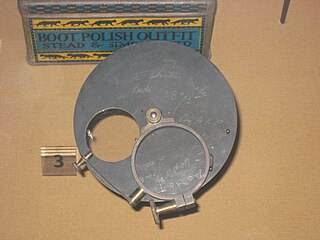
In photography, a shutter is a device that allows light to pass for a determined period, exposing photographic film or a photosensitive digital sensor to light in order to capture a permanent image of a scene. A shutter can also be used to allow pulses of light to pass outwards, as seen in a movie projector or a signal lamp. A shutter of variable speed is used to control exposure time of the film. The shutter is constructed so that it automatically closes after a certain required time interval. The speed of the shutter is controlled by a ring outside the camera, on which various timings are marked.

Selenium is a chemical element with symbol Se and atomic number 34. It is a nonmetal with properties that are intermediate between the elements above and below in the periodic table, sulfur and tellurium, and also has similarities to arsenic. It rarely occurs in its elemental state or as pure ore compounds in the Earth's crust. Selenium was discovered in 1817 by Jöns Jacob Berzelius, who noted the similarity of the new element to the previously discovered tellurium.

A galvanometer is an electromechanical instrument used for detecting and indicating an electric current. A galvanometer works as an actuator, by producing a rotary deflection, in response to electric current flowing through a coil in a constant magnetic field. Early galvanometers were not calibrated, but their later developments were used as measuring instruments, called ammeters, to measure the current flowing through an electric circuit.
The Lynx 5000 was introduced in 1962. It was an upgrade to the Lynx 1000 and replaced the photovoltaic cell with a cadmium sulfide (CdS) photoresistor, requiring a mercury battery for the light meter.

Cadmium sulfide is the inorganic compound with the formula CdS. Cadmium sulfide is a green solid. It occurs in nature with two different crystal structures as the rare minerals greenockite and hawleyite, but is more prevalent as an impurity substituent in the similarly structured zinc ores sphalerite and wurtzite, which are the major economic sources of cadmium. As a compound that is easy to isolate and purify, it is the principal source of cadmium for all commercial applications. Its vivid green color led to its adoption as a pigment for the green paint "cadmium green" in the 18th century.

A photoresistor is a light-controlled variable resistor. The resistance of a photoresistor decreases with increasing incident light intensity; in other words, it exhibits photoconductivity. A photoresistor can be applied in light-sensitive detector circuits, and light-activated and dark-activated switching circuits.

A mercury battery is a non-rechargeable electrochemical battery, a primary cell. Mercury batteries use a reaction between mercuric oxide and zinc electrodes in an alkaline electrolyte. The voltage during discharge remains practically constant at 1.35 volts, and the capacity is much greater than that of a similarly sized zinc carbon battery. Mercury batteries were used in the shape of button cells for watches, hearing aids, cameras and calculators, and in larger forms for other applications.
The Lynx 14 was released in 1965. The lens of the 1000/5000 was replaced by a large 1:1.4 45 mm with 7 elements in 5 groups. The shutter is capable of a maximum speed of 1/500 second.
In 1968 the Lynx 5000e and Lynx 14e were introduced. These variants both switched to two PX640 batteries instead of a single PX625 in order to drive a more sensitive light sensor with a higher voltage. The galvanometer of the light meter was replaced with two indicator lights, showing when the exposure was "over" or "under".

A single-lens reflex camera (SLR) is a camera that typically uses a mirror and prism system that permits the photographer to view through the lens and see exactly what will be captured. With twin lens reflex and rangefinder cameras, the viewed image could be significantly different from the final image. When the shutter button is pressed on most SLRs, the mirror flips out of the light path, allowing light to pass through to the light receptor and the image to be captured.

Zorki is the name of a series of 35mm rangefinder cameras manufactured in the Soviet Union between 1948 and 1978.

Contax began as a camera model in the Zeiss Ikon line in 1932, and later became a brand name. The early cameras were among the finest in the world, typically featuring high quality Zeiss interchangeable lenses. The final products under the Contax name were a line of 35 mm, medium format, and digital cameras engineered and manufactured by Kyocera, and featuring modern Zeiss optics. In 2005, Kyocera announced that it would no longer produce Contax cameras.

The Canon A-1 is an advanced level single-lens reflex (SLR) 35 mm film camera for use with interchangeable lenses. It was manufactured by Canon Camera K. K. in Japan from April 1978 to 1985. It employs a horizontal cloth-curtain focal-plane shutter with a speed range of 30 to 1/1000 second plus bulb and flash synchronization speed of 1/60 second. It has dimensions of 92 millimetres (3.6 in) height, 141 millimetres (5.6 in) width, 48 millimetres (1.9 in) depth and 620 grams (22 oz) weight. Unlike most SLRs of the time, it was available in only one color; all black. The introductory US list price for the body plus Canon FD 50 mm f/1.4 SSC lens was $625, the camera was generally sold with a 30–40% discount.
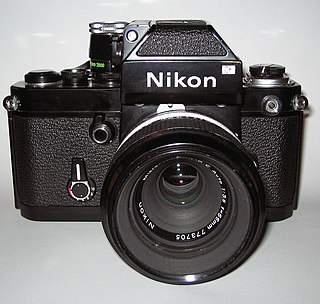
The Nikon F2 is a professional level, interchangeable lens, 35 mm film, single-lens reflex (SLR) camera. It was manufactured by the Japanese optics company Nippon Kogaku K. K. in Japan from September 1971 to 1980. It used a horizontal-travel focal plane shutter with titanium shutter curtains and a speed range of 1 to 1/2000 second plus Bulb and Time, and flash X-sync of 1/80th second. It had dimensions of 98 mm height, 152.5 mm width, 65 mm depth and 730 g weight. It was available in two colors: black with chrome trim and all black.

The Canonflex is a Canon 35 mm film single-lens reflex (SLR) camera introduced in May 1959. Its standard lens is the Canon Camera Co. Super-Canomatic R 50mm lens f/1.8. The camera was in production for one year before it was replaced by the Canonflex R2000, adding a 1/2000 sec. shutter speed.

The history of the single-lens reflex camera (SLR) begins with the use of a reflex mirror in a camera obscura described in 1676, but it took a long time for the design to succeed for photographic cameras: the first patent was granted in 1861, and the first cameras were produced in 1884 but while elegantly simple in concept, they were very complex in practice. One by one these complexities were overcome as optical and mechanical technology advanced, and in the 1960s the SLR camera became the preferred design for many high-end camera formats.

Nikkormat was a brand of cameras produced by the Japanese optics company Nippon Kogaku K. K., as a consumer version of the professional Nikon brand. Nikkormat cameras, produced from 1965 until 1978, were simpler and more affordable than Nikon-branded cameras, but accepted the same lenses as the Nikon F series cameras.
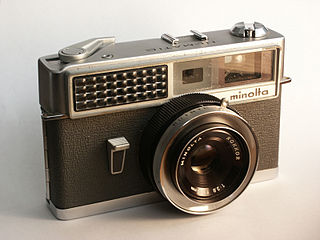
Hi-Matic was the name of a long-running series of 35 mm cameras made by Minolta. The original Hi-Matic of 1962 was the first Minolta camera to feature automatic exposure and achieved a small degree of fame when a version was taken into space by John Glenn in 1962.

The Olympus 35SP is a 35 mm rangefinder camera made by Olympus in Japan. It is the only 35mm rangefinder with a dual center-weighted average metering and spot metering system. Metering is also available in manual mode, which is quite unusual amongst Japanese rangefinder cameras of this era.

The Rollei 35 is a 35mm miniature viewfinder camera built by Rollei. The original Rollei 35, when introduced at photokina in 1966, was the smallest existing 135 film camera. The Rollei 35 series remains one of the smallest 35 mm cameras after the Minolta TC-1 and Minox 35. In 30 years, about 2 million Rollei 35 series cameras were manufactured. The Rollei 35 was manufactured by DHW Fototechnik up to 2015, the successor of Franke & Heidecke as small-batch production. The last version is the Rollei 35 Classic, an updated Rollei 35 SE.
The Konica F was the first 35 mm SLR camera produced by Konishiroku, released in February 1960. It featured a built-in light metering system to set the correct exposure. The meter utilized a large selenium cell panel on the front of the viewfinder prism to detect light levels. This type sensor cell generates its own small electric current, so the metering system does not require a battery. On the other hand, selenium cells are known to degrade over time, losing accuracy or eventually failing. Many cameras and handheld meters relied upon selenium cells at one time, but they were gradually replaced by CdS and other types of cells that require a battery but tend to give long-term reliability. Between 600 and 1500 total Konica Fs were produced, making it a highly sought-after camera.

The Konica Hexar RF is a 35 mm rangefinder camera which was sold by Konica. It was introduced to the market on 13 October 1999. and subsequently discontinued some time before the end of 2003. The camera used the "Bayonet Konica KM-mount", a copy of the Leica M-mount, thus sharing interchangeable lenses with those designed for Leica cameras and others compatible with them. The Hexar RF has a combined rangefinder/viewfinder modeled on that of Leica cameras, a similar body shape and size - and so is similar to Leica M-mount cameras in many aspects of operation.

The Minolta CLE is a TTL-metering automatic exposure aperture-priority 35 mm rangefinder camera using Leica M lenses, introduced by Minolta in 1980.
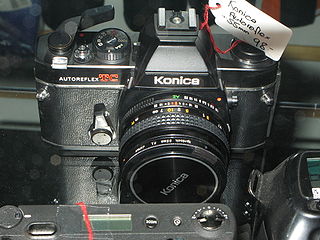
The Auto-Reflex and Autoreflex is a series of 35mm SLR cameras made by Konica from 1965. All these models have the Konica AR bayonet.
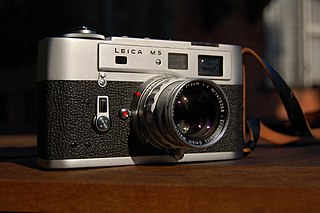
The Leica M5 is a 35 mm camera by Leica Camera AG, introduced in 1971. It was the first Leica rangefinder camera to feature through-the-lens (TTL) metering and the last to be made entirely in Wetzlar by hand using the traditional "adjust and fit" method.
Zuiko is a brand of optical lenses made by Olympus Corporation that was used up to and including the Four Thirds system era. At the inception of the Micro Four Thirds system, new lenses for that system started to be branded as M.Zuiko Digital.

The Minolta SR-7 is a 35 mm single-lens reflex camera (SLR) made by Minolta, produced from 1962 to 1966. It is notable for being the first SLR camera with a built in CdS light meter.
























